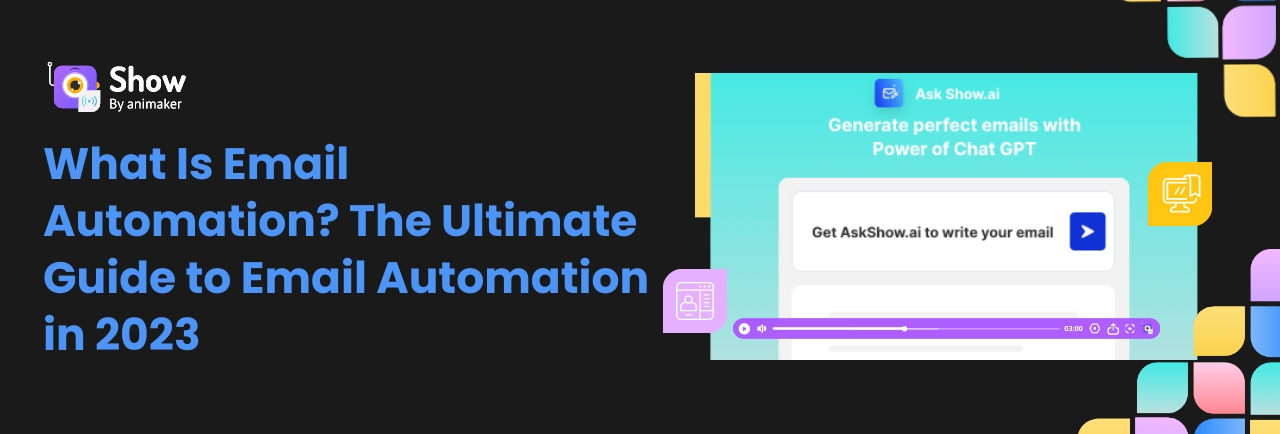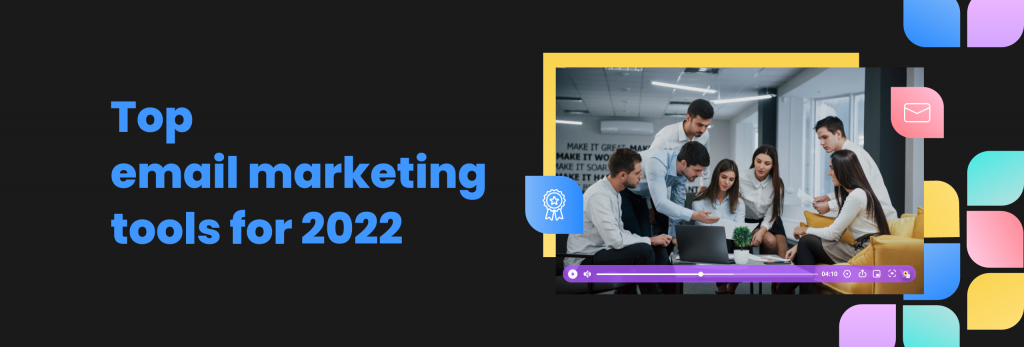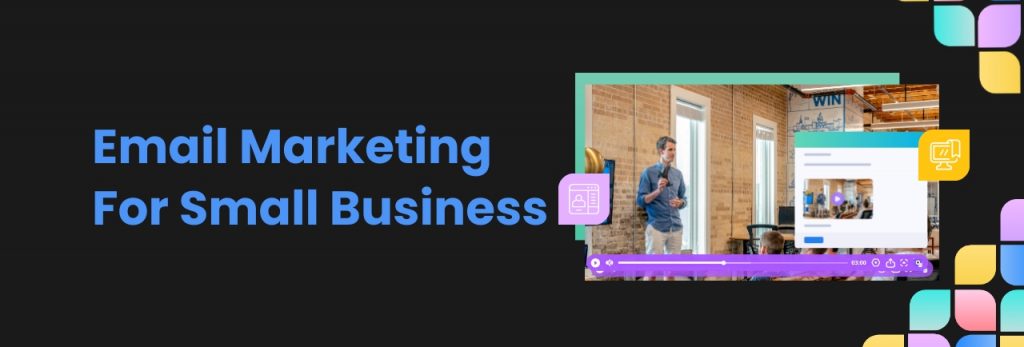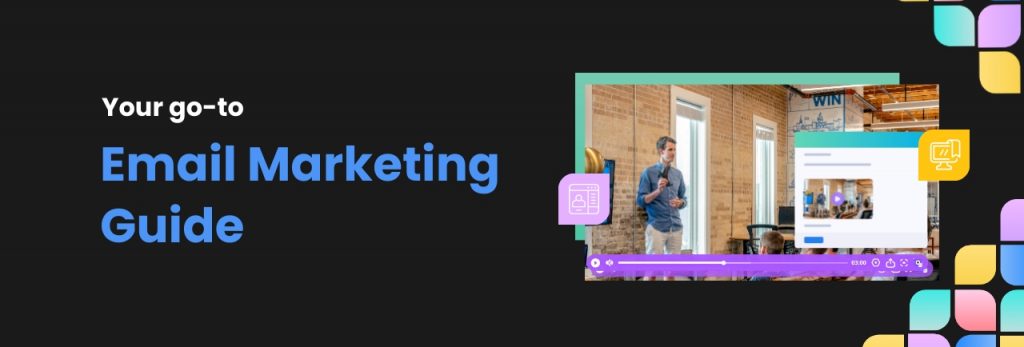Contents
How to Make Email Automation More Effective
How to Automate Email Workflows
Different Types of Email Workflows
What Is Email Automation? The Ultimate Guide to Email Automation in 2023
Email automation unlocks the full potential of your marketing efforts by ensuring that you never miss major opportunities to nurture and engage your target audience and contacts. Without this powerful tool in your arsenal, your marketing team might find it challenging to maintain a consistent and personalized approach to email campaigns. In this article, we will explore email marketing automation and give you tips to harness its power.
As a business owner, you understand the importance of conserving valuable resources, especially time. Your primary focus should be on growing your business, not getting caught up in the mundane tasks of sending out emails or managing customer service inquiries. Fortunately, there's a solution that can help you reclaim your time and streamline your efforts: email automation.
Email automation tools provide the key to unlocking efficiency and productivity in your email marketing endeavors. By automating various aspects of your email campaigns, you can save both time and money. But what exactly is email automation?
What Is Email Automation?
Email automation is a game-changer when it comes to reaching your audience with tailored messages at the perfect moment, all without the need for manual intervention. This powerful technique harnesses the capabilities of email automation tools, allowing you to leverage predefined rules and create personalized email campaigns that resonate with your customers.
At its core, it is a method of automating the sending of emails based on specific actions or triggers taken by your customers. By utilizing a marketing automation tool like Show, you can set up a series of automated messages that are triggered by customer behavior or lack thereof. For instance, email automation can be set up for a customer who has not completed a purchase. This ensures that each customer receives relevant and timely emails without you having to manually send them. Now, let’s explore the benefits of email automation.
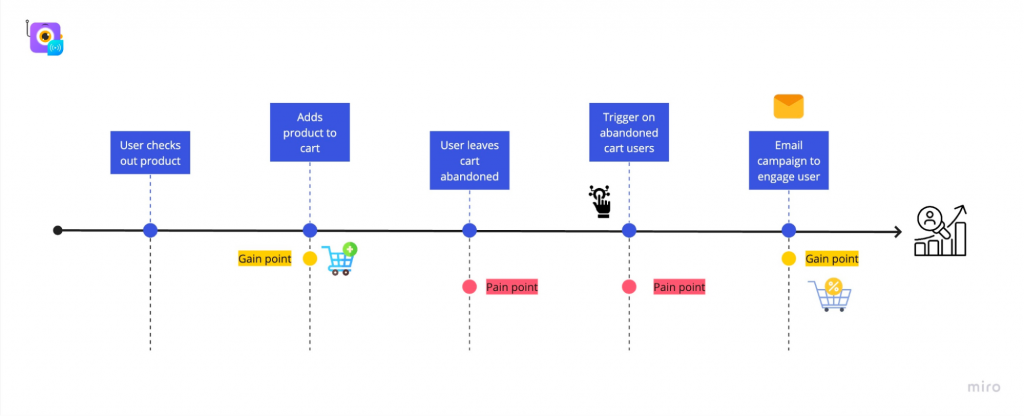
Why Businesses Should Use Email Automation?
Email automation has revolutionized the way businesses communicate with their customers. By leveraging the power of technology and utilizing email automation tools, companies can streamline their email marketing efforts and achieve impressive results.
Email automation enables you to automate the process of sending emails, saving you time and effort. You can create automated email campaigns that are triggered by specific actions or events, ensuring that your messages reach the right people at the right time. Whether it's welcoming new subscribers, nurturing leads, or re-engaging inactive contacts, automated emails can be tailored to deliver relevant and personalized content.
With automated email sending, you can consistently engage with your audience without manually composing and sending individual emails. This not only improves efficiency but also allows you to maintain a consistent and timely communication flow.
Furthermore, automated email services and systems provide robust features and functionalities to enhance your email marketing efforts. These tools offer segmentation capabilities, allowing you to target specific segments of your audience with tailored messages. You can also track and analyze the performance of your automated email campaigns, gaining valuable insights into customer behavior and engagement.
In summary, email automation is a game-changer for businesses seeking to optimize their email marketing strategies. By automating emails, utilizing the right tools, and implementing well-crafted automated email campaigns, you can effectively engage your audience, drive conversions, and ultimately achieve your marketing goals.
Benefits of Email Automation
Email automation has revolutionized the way businesses connect with their customers. By leveraging the power of email automation tools, businesses can unlock a range of benefits that enhance their marketing strategy and drive success. Let's explore the key advantages of email automation:
1. Personalize Your Customers' Experiences
Email automation allows you to deliver personalized messages tailored to each customer's preferences and behaviors. In fact, Sending targeted and personalized emails using an email automation platform drives 18 times more revenue. By segmenting your audience and creating automated email campaigns, you can deliver relevant content at the right time, fostering a deeper connection and boosting engagement.
2. Make the Most of Your Marketing Team
With email automation, your marketing team can focus on high-value tasks instead of manually sending out individual emails. By automating repetitive tasks like email scheduling and sending, your team can allocate their time and expertise to strategic initiatives, driving overall marketing effectiveness.
3. Improve Your Customer Retention Rate
Nurturing customer relationships is crucial for long-term success. Email automation enables you to create targeted, automated email campaigns that keep your customers engaged throughout their journey. Unsurprisingly, 52% businesses use emails as a means to retain their customers. By delivering timely and personalized messages, you can strengthen customer loyalty, increase retention, and encourage repeat business.
4. It Makes Your Marketing Strategy Scalable
As your business grows, it becomes challenging to maintain personalized communication with a growing customer base. Email automation solves this problem by allowing you to scale your marketing efforts without sacrificing personalization. With automated email campaigns, you can efficiently reach a larger audience while delivering tailored content that resonates with each individual.
How to Make Email Automation More Effective
Email automation can significantly enhance your marketing efforts, driving better results and engagement. To optimize the effectiveness of your email automation, consider the following strategies:
1. Track responses to collect more information
Utilize the tracking capabilities of your email automation tool to gain valuable insights. Monitor recipient actions, such as open rates, click-through rates, and conversions. By analyzing this data, you can refine your email campaigns, tailor content to your audience's preferences, and continuously improve your results.
2. Offer Discounts Strategically
Incorporate strategic discount offers within your automated email campaigns. Personalize these offers based on customer behavior or specific triggers. By providing exclusive discounts or promotions, you can incentivize conversions, encourage customer loyalty, and drive sales.
3. Create Automated Drip Campaigns
Implement automated drip campaigns to nurture leads and guide them through the customer journey. Develop a series of relevant and timely emails that are sent based on predefined triggers or specific actions taken by your subscribers. Drip campaigns keep your brand top of mind, build engagement, and gradually move prospects closer to conversion.
By leveraging these strategies, you can enhance the effectiveness of your email automation efforts, deliver targeted content, and drive better engagement and conversions.
How to Automate Email Workflows
Automating email workflows is an effective way to streamline your marketing processes and improve engagement. Here's a step-by-step guide to help you automate your email campaigns, along with examples for each point:
Automating email workflows is an efficient way to streamline your marketing processes and save valuable time. Here's how you can effectively automate your email campaigns and ensure their success:
1. Select the right email automation software
Choose a reliable and feature-rich email automation tool like Show's AI-Powered Email Automation, which offers intuitive interfaces, robust functionality, and seamless integration with existing systems. With its advanced features and user-friendly interface, you can easily automate your email campaigns.
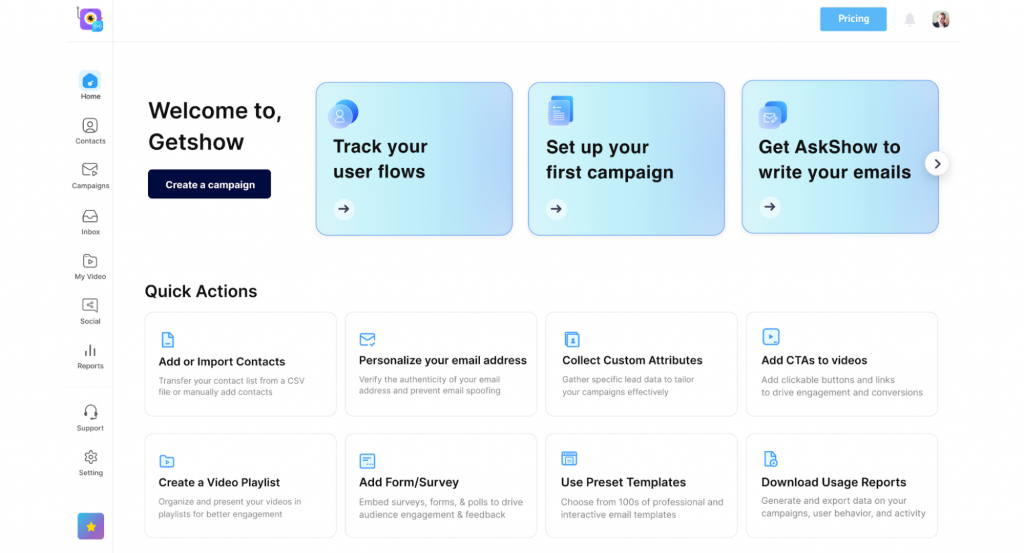
2. Identify your target audience
Define specific segments based on demographics, purchase history, or engagement level. For example, segment your subscribers based on their interests and send targeted content that resonates with them. Personalize your emails with dynamic content using email automation tools.
3. Define your campaign goal
Establish clear objectives for your email campaign, such as generating leads or nurturing prospects. For instance, create a drip campaign that delivers a series of educational content to nurture leads and move them closer to conversion.
4. Set Enrollment Criteria
Determine the triggers that automatically enroll contacts into your email workflows. For example, if a visitor downloads a gated content piece from your website, they can be enrolled in a lead nurturing email series to further engage and convert them.
5. Determine Which Processes to Automate
Identify processes like welcome emails, abandoned cart reminders, or post-purchase follow-ups that can be automated. For instance, automatically send personalized product recommendations to customers based on their browsing or purchase history.
6. Create Compelling Email Assets
Craft engaging email content with persuasive subject lines, personalized recommendations, and clear call-to-action buttons. For example, use email automation tools to dynamically insert product images and descriptions based on customer preferences.
7. Test and Optimize Your Setup
Before launching, thoroughly test your automated email workflows. Send test emails to different devices and email clients to ensure proper rendering. Monitor key metrics like open rates and click-through rates to optimize your email performance.
8. Go live and monitor the progress
Activate your automated email workflows and closely monitor their performance. Track key metrics like conversion rates and adjust your campaigns accordingly. For example, tweak the subject lines or timing of your emails to improve engagement.
By following these steps and leveraging the power of email automation tools like Show's AI-Powered Email Automation, you can streamline your marketing workflows, deliver personalized experiences, and drive better results for your business.
Different Types of Email Workflows
1. Topic Workflows
Suppose you run an online fitness platform that offers workouts, nutrition plans, and wellness tips. You can create topic workflows such as "weight loss," "strength training," and "healthy recipes." When a contact shows interest in a specific topic by downloading an ebook or viewing related content, trigger an automated workflow that delivers personalized content, workout routines, recipe ideas, and nutrition tips tailored to their specific interests.
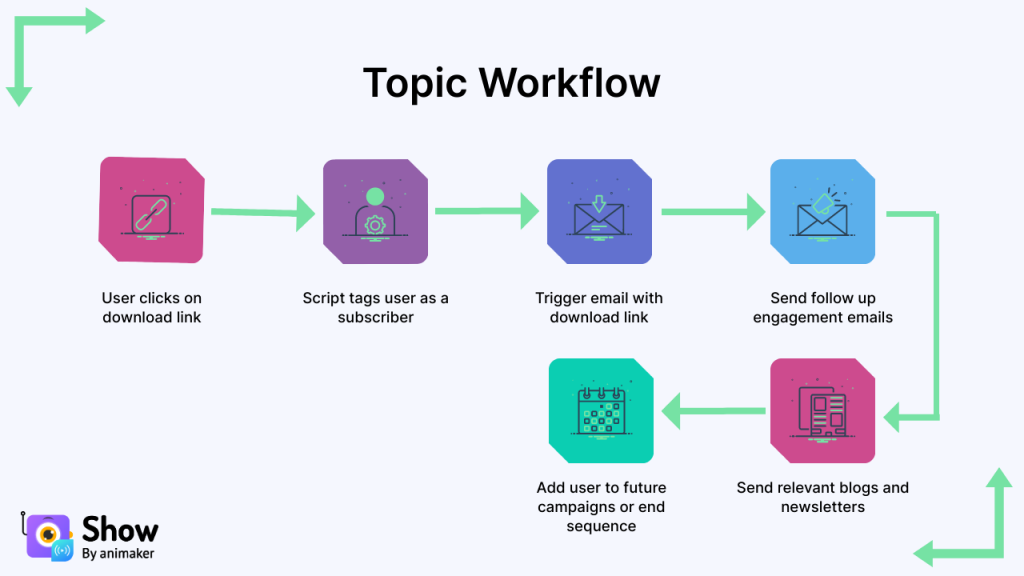
2. Blog Subscriber Welcome Workflow
Welcome new blog subscribers with a personalized email using an email automation tool. Thank them for subscribing, highlight the benefits of reading your blog, and provide options for adjusting their subscription settings. Use the opportunity to promote your best-performing articles or other offers to engage and nurture your blog subscribers right from the start.
New Customer Welcome/Training Workflow: When a contact becomes a new customer, trigger a series of automated welcome emails using an email automation system. These emails can provide essential information, account setup instructions, and access to training resources. Gradually introduce customers to the features and benefits of your product or service, helping them get up to speed and maximize their experience.
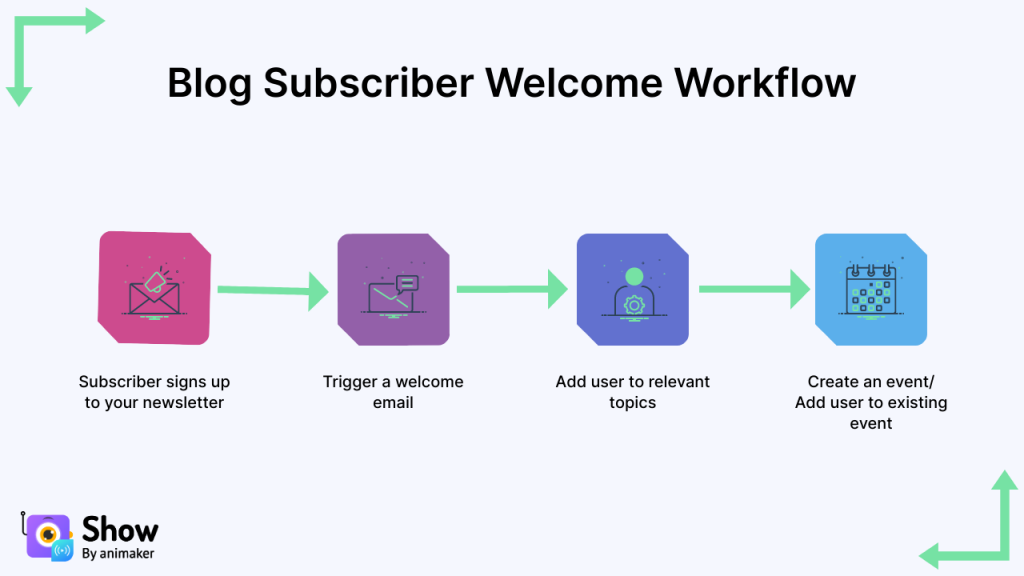
3. Engaged Contact/Evangelist Workflow
Identify highly engaged contacts using triggers such as website visits, clicks, or form submissions, and create a dynamic list using an automated email service. Develop an email workflow that rewards and encourages these contacts to become brand evangelists. Offer exclusive content, rewards, or referral incentives to foster their loyalty and turn them into advocates who share your top content on social media or with their network.
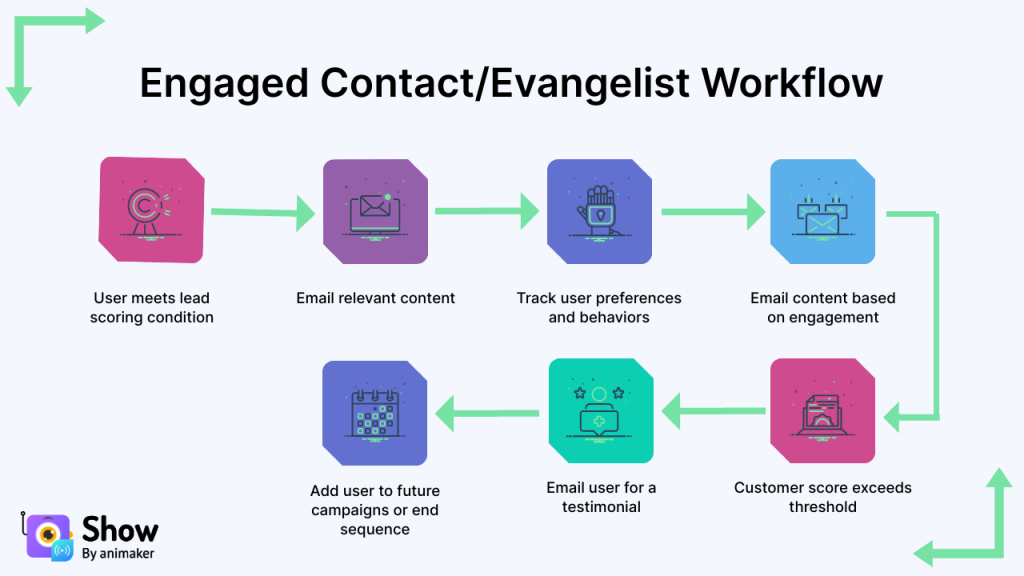
4. Lead Nurturing Workflow
Set up lead nurturing workflows using an email automation tool to guide leads through the buyer's journey. Based on multiple beginning-stage conversion events, such as downloading ebooks or attending webinars, send targeted emails containing more valuable content that advances leads further into the sales process. Gradually provide information and offers that address their specific needs and pain points, nurturing them until they are ready for a sales conversation.
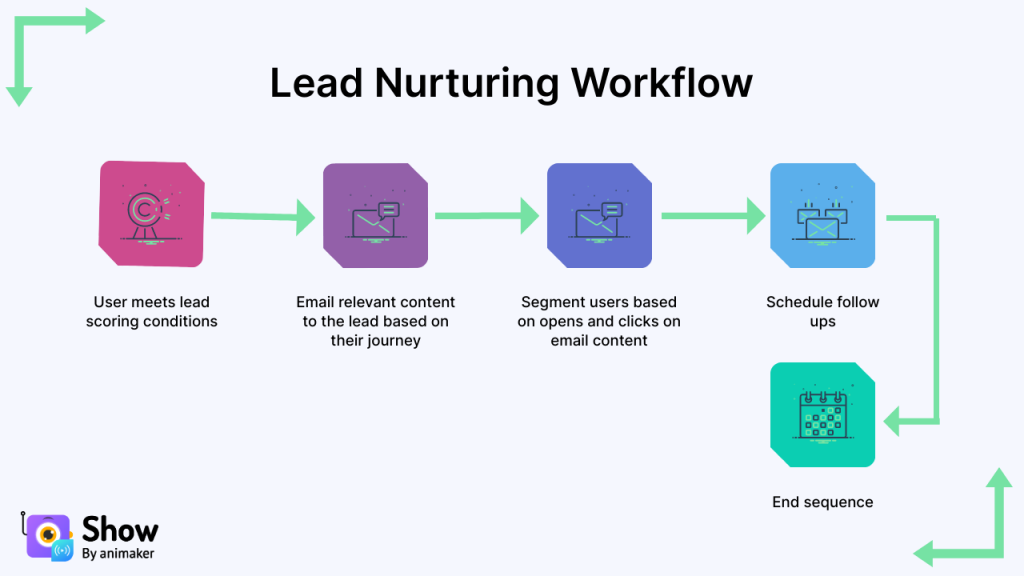
5. Internal Sales Rep Notification Workflow
Identify late-stage page views or conversion events using an attribution reporting tool. Trigger automated email notifications to inform your sales representatives about these high-value activities. Personalize the email with relevant information about the lead, including mid and late-stage content they can use in their outreach efforts. This enables sales reps to connect with the best leads at the right time, increasing their chances of closing deals.
6. Re-engagement Workflow
Re-engage inactive contacts using automated re-engagement campaigns. Set specific list criteria, such as the length of time since their last form submission, website visit, or email click, to trigger an email workflow. Send them exclusive offers or coupons to reignite their interest and encourage them to re-engage with your company. Use email automation to segment and target these contacts with tailored content that addresses their previous interactions or preferences.
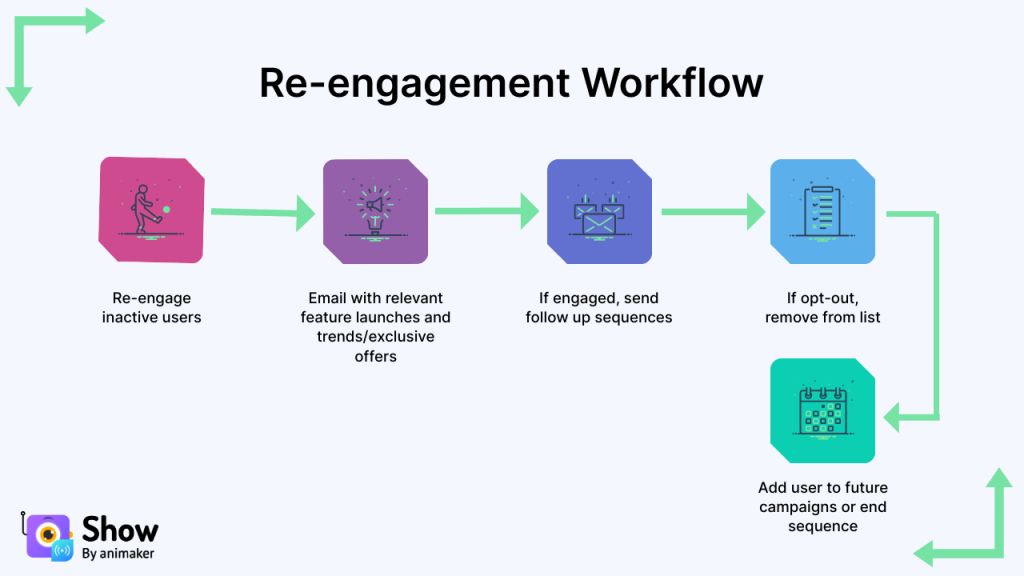
7. Event Workflow
Automate communication with event registrants and attendees using email workflows. Prior to the event, send important information such as event details, agenda, and logistics. During the event, provide updates, session reminders, and access to additional resources. After the event, continue nurturing attendees with follow-up emails, session slides, and promotions for future events, all done through an automated email service.
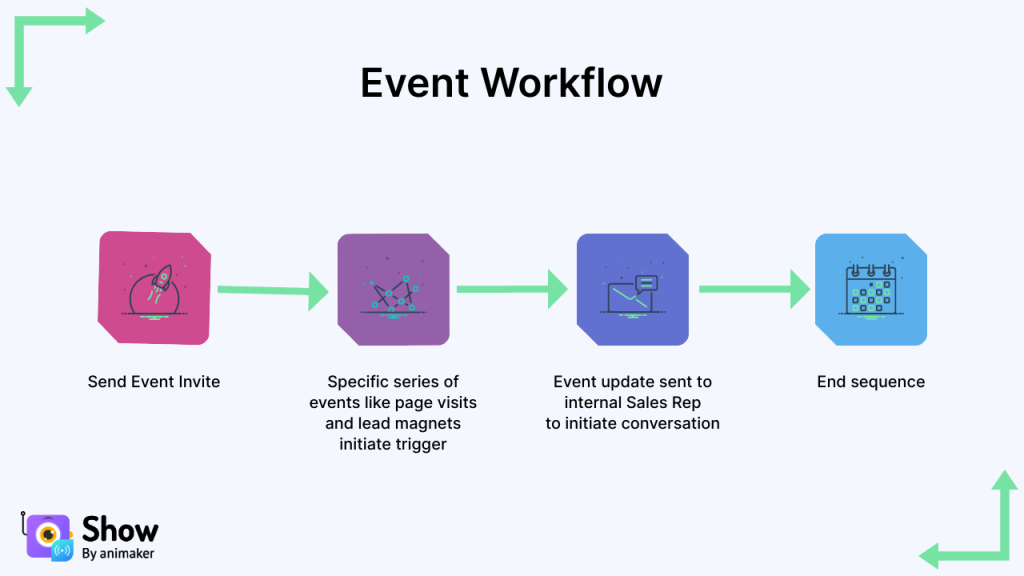
8. Abandoned Shopping Cart Workflow
Implement an abandoned shopping cart workflow for your e-commerce business. When a contact adds items to their shopping cart but doesn't complete the purchase, trigger an automated email series that reminds them of their abandoned cart. Use personalized messages, offer special discounts or incentives, and provide a direct link back to their cart to encourage them to complete the purchase. Utilize an email automation tool to automatically send these emails and track the effectiveness of your abandoned cart recovery efforts.
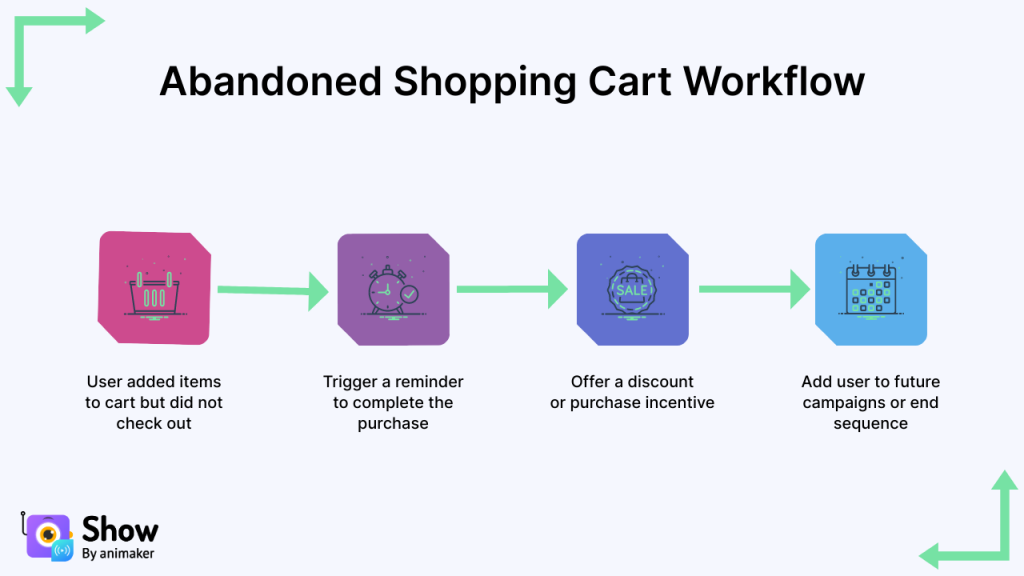
9. Upsell Workflow
Continue engaging with your customers even after they make a purchase by using upsell workflows. Identify customers who have made previous purchases and create dynamic lists based on their buying history or specific products. Set up automated email campaigns that recommend related products, offer complementary services, or promote exclusive upgrades or add-ons. By leveraging the power of email automation and customer segmentation, you can increase revenue and drive repeat purchases from your existing customer base.
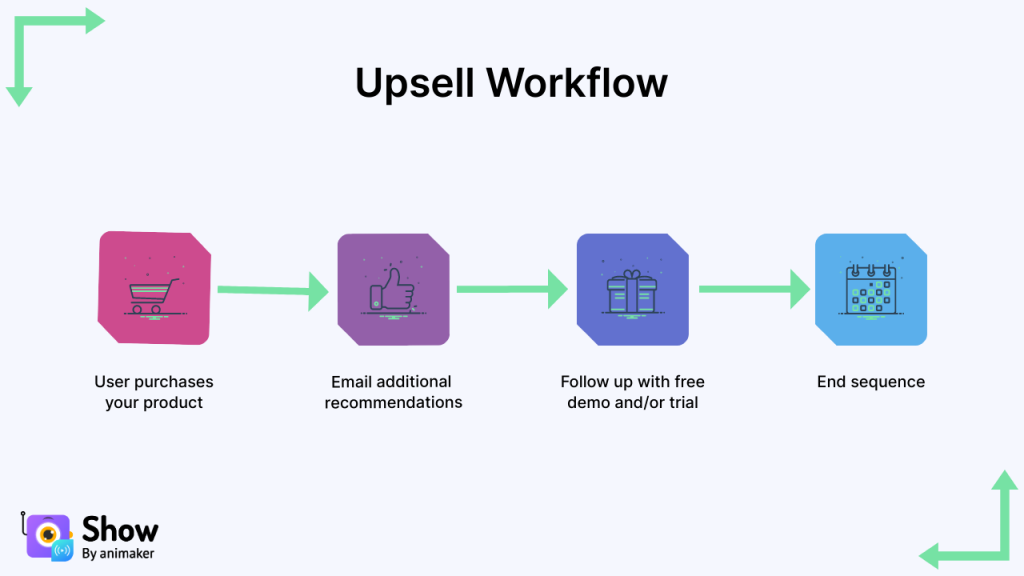
10. New Customer Welcome/Training Workflow
When a contact becomes a new customer, trigger a series of automated welcome emails using an email automation system. These emails can provide essential information, account setup instructions, and access to training resources. Gradually introduce customers to the features and benefits of your product or service, helping them get up to speed and maximize their experience.
By incorporating email automation, automated email campaigns, and utilizing email automation tools, you can streamline your marketing efforts, engage with your audience in a targeted manner, and drive conversions. These workflows, such as topic workflows, blog subscriber welcome workflows, new customer welcome/training workflows, engaged contact/evangelist workflows, lead nurturing workflows, internal sales rep notification workflows, re-engagement workflows, event workflows, abandoned shopping cart workflows, upsell workflows, help you deliver the right content, at the right time, to the right audience, ultimately enhancing the overall customer experience and driving business growth.
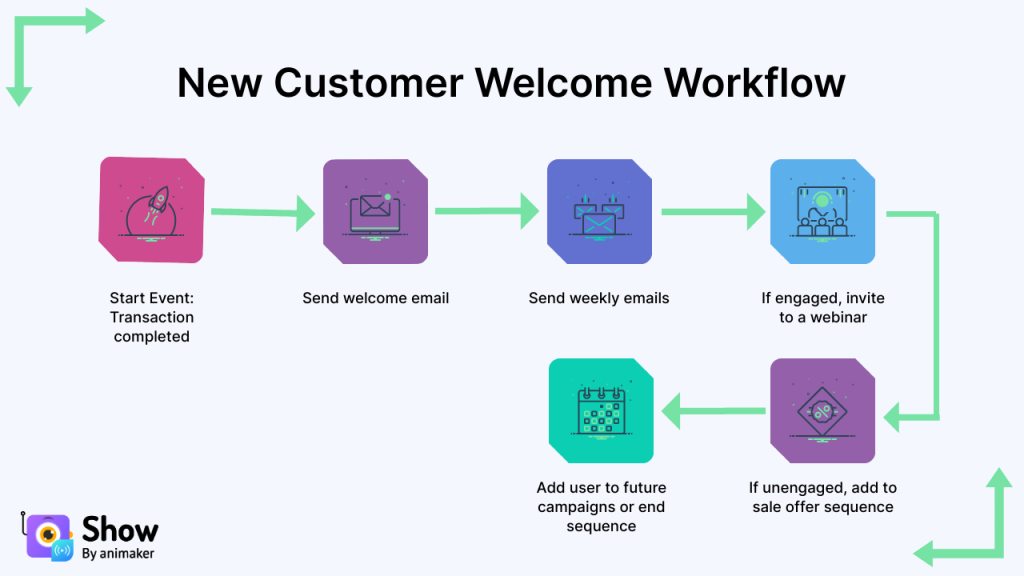
11. Customer Happiness Workflow
Utilize the Net Promoter Score (NPS) to measure customer satisfaction. Set a threshold for your ideal customer happiness score and create a dynamic list of happy customers. Trigger a customer happiness workflow for customers with high NPS scores, offering them exclusive content, rewards, or discounts to further delight them. For customers with low NPS scores, trigger a different workflow that provides resources and offers aimed at addressing their concerns and improving their happiness. Segment the unhappy customers based on specific reasons for their dissatisfaction to send targeted workflows addressing their specific issues.
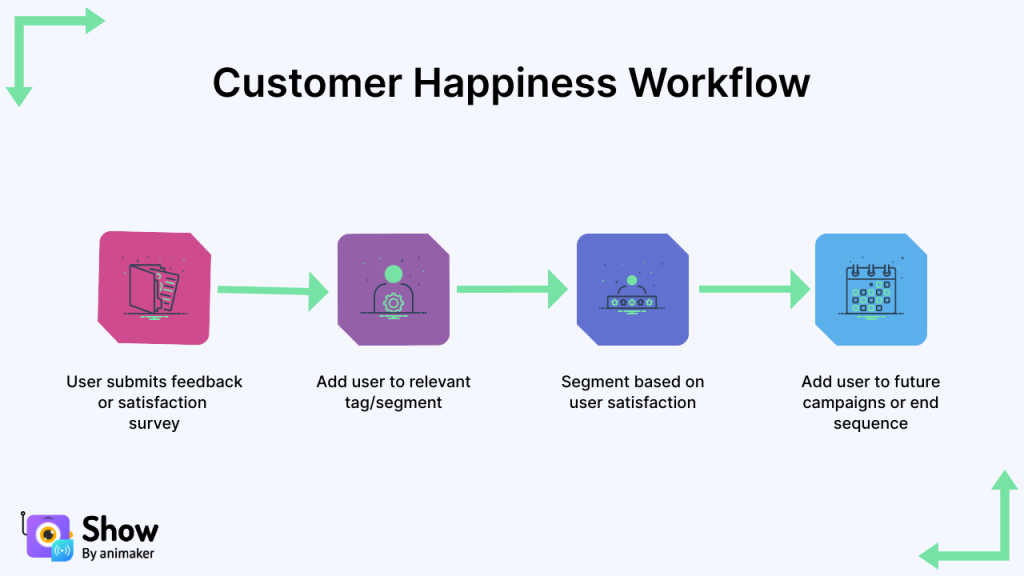
12. Customer Success/Engagement Workflow
Track customer success metrics and product usage to identify opportunities for customer engagement. Trigger an email workflow to customers who meet certain success metrics, asking if they would be interested in being featured as a success story. For customers with low product engagement, trigger a workflow that provides educational resources and training materials to help them fully utilize the product's features and enhance their experience.
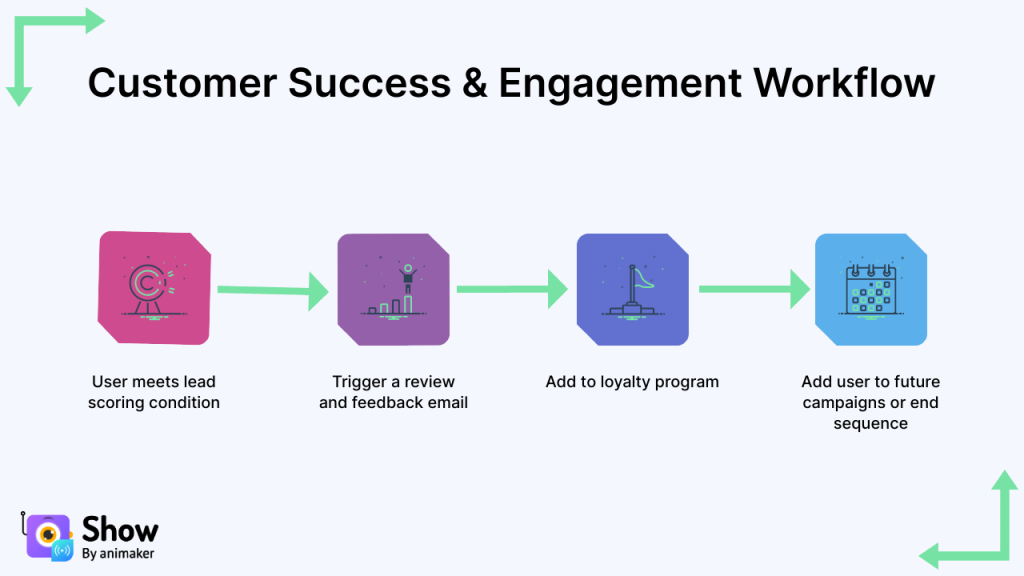
13. Upcoming Purchase Reminder Workflow
Identify customers who make purchases on a cycle, such as subscription-based or replenishment products. Enroll them in a workflow that triggers a reminder email when their next purchase is approaching. For example, if a customer purchases a six-month supply of prescription contacts, send them an automated email five months later as a reminder to order a new batch.
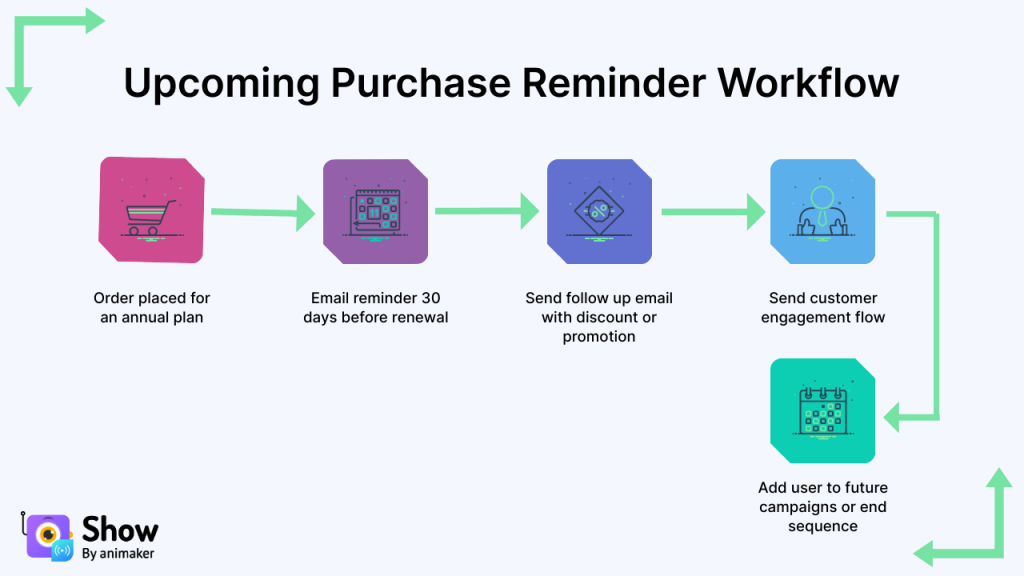
14. Customer Service or Ticket Workflow
When customers or prospects reach out to your customer service via email or an online form, create a workflow that converts their inquiries into support tickets. Categorize and assign these tickets to your customer service representatives for efficient handling and resolution. This workflow helps streamline customer service processes, tracks ongoing issues, and ensures timely responses to customer concerns.
15. Deal-Based Workflows
Automate aspects of the deal-closing process to free up time for your sales representatives. Businesses can automate confirmation emails when a prospect becomes a client or a qualified lead. Additionally, leverage workflow automation to update the contact's status in your system, reflecting their position in the customer lifecycle. This ensures smooth transition and efficient management of deals.
The Best Tool for Email Automation: Show
1. Show's Comprehensive CRM Solution: Empowering Email Automation
Show distinguishes itself by offering a comprehensive CRM system integrated seamlessly with its powerful email marketing platform. With Show, businesses can consolidate all customer data and email marketing tools in one place, simplifying workflows for marketing and sales teams. The built-in CRM is highly customizable, allowing businesses to tailor and personalize email campaigns for timely and relevant communication with customers.
2. Effortlessly Set Up Automated Email Responses
Automated email responses often lack a personal touch, but with Show's CRM and Email Marketing tool, creating automated, personalized, and tailored email responses becomes a breeze. Whether you need automated customer service responses or targeted automated emails across your contact list, Show provides a user-friendly interface to set up customized rules for automated email responses.
3. Harness the Power of OmniScript Tracking
Unlike many marketing automation tools, Show offers an in-built Omniscript Tracking feature, enabling businesses to track their users' journey effortlessly. From a CRM Email Marketing perspective, the Omniscript tracking feature adds nuance to segmentation, allowing for highly targeted and refined email campaigns that resonate with customers on a deeper level.
4. Refine Your Campaigns with Advanced Segmentation
Segmentation is a fundamental aspect of any CRM system, and Show excels in this regard, enabling businesses to segment their audience effectively. Going beyond basic segmentation, Show allows businesses to create and customize rules for more intricate and layered segmentation. This in-depth audience segmentation empowers businesses to refine their email marketing campaigns, reaching the right audience with the right message at the right time.
5. Simplify Workflow Automation with Intuitive Builder
Show takes the complexity out of workflow automation with its intuitive and user-friendly marketing email automation workflow builder. Moreover, Businesses can effortlessly create intricate workflows without the need for technical expertise or excessive effort. Hence, Show's streamlined approach to building email automation workflows ensures that businesses can save time and resources while maximizing their email marketing strategies.
6. Show AI: AI-Powered Email Generator Tool
In addition to its CRM and email marketing capabilities, Show offers AskShow.AI, an innovative AI-powered email generator tool. With AskShow.AI, businesses can generate email content based on prompts, similar to having a ChatGPT for emails. This feature simplifies and streamlines email marketing campaigns, empowering businesses to optimize their communication efforts.
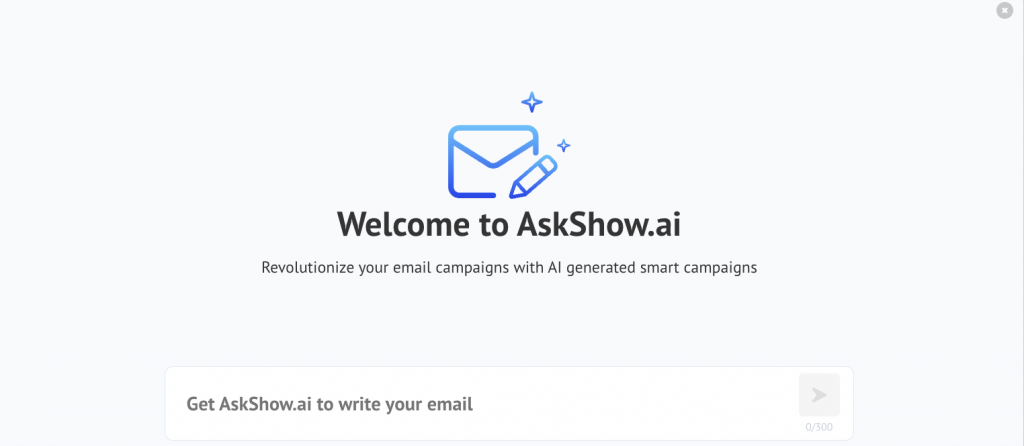
7. Enable Email Analytics with Show
Furthermore, Show provides robust email analytics capabilities, allowing businesses to gain insights into the performance of their email marketing campaigns. Through detailed metrics and reports, businesses can evaluate the effectiveness of their strategies, make data-driven decisions, and continually improve their email communication to drive engagement, conversions, and business growth.
Conclusion
In conclusion, email automation has become an indispensable tool for businesses looking to maximize the effectiveness of their email marketing campaigns. By utilizing email automation tools and implementing automated email workflows, companies can personalize customer experiences, improve team efficiency, boost customer retention rates, and scale their marketing strategies.
By embracing Show's robust email automation capabilities, businesses can enhance their email marketing campaigns, automate processes, and deliver personalized experiences to their audience, ultimately driving engagement, conversions, and business growth.
Frequently Asked Questions (FAQs)
1. What is single mail automation?
Single mail automation refers to the process of automating the sending of individual emails based on specific triggers or actions. Unlike automated email campaigns that involve a series of pre-scheduled emails, single mail automation focuses on sending personalized, one-time emails in response to specific events or behaviors. It allows businesses to deliver timely and targeted messages to their contacts without the need for manual intervention.
2. What is an email automation flow?
An email automation flow, also known as an email workflow or drip campaign, is a series of automated emails that are sent to contacts based on predefined triggers and actions. It is designed to guide contacts through a predefined journey, delivering relevant and timely content to nurture and engage them. An email automation flow typically includes a sequence of emails that are sent at predetermined intervals, with each email building upon the previous one to move contacts closer to a desired goal or conversion.
3. What are three email automation hacks to make your email automation better?
a. Personalize your emails: Use the data you have about your contacts to personalize your email content, subject lines, and greetings. Incorporate dynamic content and merge tags to create a more personalized and tailored experience for each recipient.
b. Segment your audience: Divide your contacts into specific segments based on demographics, interests, behaviors, or engagement levels. By sending targeted emails to each segment, you can deliver more relevant content and improve engagement and conversion rates.
c. Test and optimize: Continuously test different elements of your email automation, such as subject lines, email copy, CTAs, and send times. Analyze the results and make data-driven decisions to optimize your email automation flow for better performance and higher ROI.
By leveraging these email automation hacks, businesses can enhance the effectiveness of their email campaigns, increase customer engagement, and drive better results.
4. How to avoid emails landing in spam?
Avoiding the spam folder starts with ensuring that your email subject lines are not spammy-sounding. The subject line is the first impression readers have of your emails, and if it sounds like spam, it may lead to your emails being marked as such. Additionally, spam filters can flag subject lines that contain all caps, promotional language, or phrases like "RE:" or "FWD:". To prevent this, it's crucial to craft subject lines that are clear, concise, and relevant to the email content.
Adhering to email marketing regulations, such as the CAN-SPAM Act of 2003, is also essential. These regulations set guidelines to prevent businesses from spamming recipients with marketing emails. Whether you're creating single emails or automated email series, ensure that you comply with these regulations to maintain a positive reputation and avoid legal issues.
Requesting your readers to whitelist your emails instead of marking them as spam can be helpful. Whitelisting means that recipients add your email address to their trusted contacts, ensuring that your emails bypass spam filters and land in their inboxes. Encourage your subscribers to whitelist your email address to establish trust and credibility as an email sender.
Choosing a reputable email marketing and automation tool, such as Show, can significantly impact the deliverability of your emails. These tools provide features and infrastructure that help you comply with CAN-SPAM regulations and navigate spam filters effectively. Show, for example, offers reliable email delivery and compliance with industry standards, ensuring that your emails reach the intended recipients' inboxes.
By implementing these strategies and leveraging a trusted email marketing and automation tool like Show, you can enhance email deliverability, maintain compliance with regulations, and build a trustworthy reputation as an email sender.
